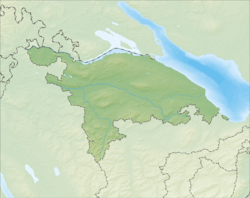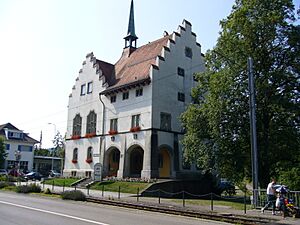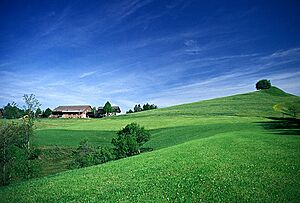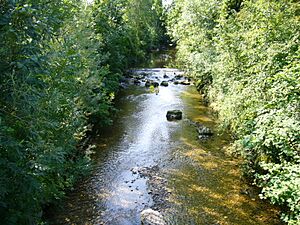Münchwilen, Thurgau facts for kids
Quick facts for kids
Münchwilen
|
||
|---|---|---|

Münchwilen village
|
||
|
||
| Country | Switzerland | |
| Canton | Thurgau | |
| District | Münchwilen | |
| Area | ||
| • Total | 7.81 km2 (3.02 sq mi) | |
| Elevation | 515 m (1,690 ft) | |
| Population
(Dec 2020 )
|
||
| • Total | 5,830 | |
| • Density | 746.5/km2 (1,933.4/sq mi) | |
| Postal code |
9542
|
|
| Localities | Münchwilen, St. Margarethen | |
| Surrounded by | Bettwiesen, Bronschhofen (SG), Eschlikon, Sirnach, Wängi, Wil (SG) | |
| Twin towns | Leuk (Switzerland) | |
Münchwilen is a town in Switzerland. It is the main town of the Münchwilen district in the Thurgau area. Münchwilen is known for its history and its role as a center for local businesses.
Contents
A Look at Münchwilen's History
Münchwilen was first mentioned in old writings around 1160. Back then, it was called Munchiwillar. Other nearby places like Oberhofen and Sankt Margarethen were also mentioned around the same time.
For a long time, Münchwilen was part of a larger area called Sirnach. But in 1950, Münchwilen, Oberhofen, and St. Margarethen decided to join together. They formed their own independent town called Münchwilen.
Münchwilen Through the Years
Münchwilen was part of the lands owned by the Abbey of St. Gallen in the 1100s. Later, from the late 1400s until 1798, it was governed by officials from the Swiss Confederation.
For a long time, people in Münchwilen went to church in Sirnach. In 1935, a new church group was formed in Münchwilen for the Protestant faith. They built their own church in 1937. Later, in 1968, a Catholic church was also built.
The Murg river helped Münchwilen grow. A mill was built in 1601 using the river's power. A bridge over the Murg river was built in 1774. Better roads also helped the town develop.
In the 1800s, factories started to appear. A cotton mill opened in 1817. Other companies like the Heitz cotton factory and Zellweger spinning mill also grew. By 1866, one company alone employed about a thousand people working from home.
Münchwilen became an important industrial center. In 1871, it replaced Tobel as the main town for the district. When the Frauenfeld-Wil train opened in 1887, the town grew even more. Big companies like Sutter (which made cleaning products) and Swisstulle AG (a fabric company) set up businesses here.
Oberhofen bei Münchwilen
Oberhofen was a village that joined Münchwilen in 1950. It was also part of the Sirnach church area until 1935. Most people in Oberhofen were Protestant.
Oberhofen was an industrial village. It was connected to Münchwilen by a bridge over the Murg river. A large factory that made shoe polish, founded by Sutter, was a major employer here. This factory later became part of Johnson Diversey and provided many jobs.
Sankt Margarethen
Sankt Margarethen is another village that became part of Münchwilen. It had its own church as early as 1275. A special chapel, the St. Margaretha chapel, was a popular place for pilgrims in the 1600s and 1700s.
Like Oberhofen, Sankt Margarethen also had mills and was involved in spinning, weaving, and embroidery in the 18th and 19th centuries. The Swisstulle AG and Huco AG factories also played a big role in the village's economy.
Münchwilen's Geography
Münchwilen covers an area of about 7.79 square kilometers (3 square miles). A large part of this land, about 66.6%, is used for farming. About 10% is covered by forests. The rest of the land, about 23.1%, has buildings and roads.
The town is located north-west of Wil in the Murg river valley. Münchwilen includes the main villages of Münchwilen, Oberhofen bei Münchwilen, and Sankt Margarethen. It also has smaller communities called hamlets, such as Freudenberg and Mezikon.
Who Lives in Münchwilen?
Münchwilen has a population of about 4,746 people. About 17.7% of the people living here are from other countries.
Most people in Münchwilen speak German, which is about 86.8% of the population. The next most common languages are Italian (4.3%) and Turkish (2.1%).
The population is almost evenly split between males and females. About 11.6% of the population are children aged 0-9 years old. Another 13.8% are teenagers aged 10-19. The largest group is adults aged 40-49, making up 17.1% of the population.
Most people in Münchwilen live in families. About 58.5% of households are couples with children.
In the 2007 federal election, the SVP was the most popular party, getting 44.82% of the votes.
Here's how the population has changed over time:
| Year | Population Münchwilen |
Population Oberhofen bei Münchwilen |
Population Sankt Margarethen |
|---|---|---|---|
| 1850 | 400 | 318 | 245 |
| 1900 | 585 | 486 | – |
| 1910 | – | 677 | – |
| 1941 | 1,046 | 641 | 513 |
| Year | Population, Münchwilen | ||
| 1950 | 2,540 | ||
| 1990 | 3,597 | ||
| 2000 | 4,553 | ||
Important Historical Sites
The St. Margarethen Chapel is a very important historical building in Switzerland. It is recognized as a national heritage site.
Münchwilen's Economy
Münchwilen has a strong economy. In 2007, the unemployment rate was low, at 1.88%.
Many people work in different types of jobs. About 92 people work in farming. A large number, 1,090 people, work in factories and manufacturing. Another 876 people work in services, like shops or offices.
Many people who live in Münchwilen also work there. About 1,243 people travel into Münchwilen for work each day. Most people use a private car to get to work, while some use public transportation.
Religion in Münchwilen
According to a census in 2000, about 42.6% of the people in Münchwilen are Roman Catholic. About 35.7% belong to the Swiss Reformed Church (Protestant).
There are also smaller groups of people who belong to other Christian churches, the Orthodox Church, and Islam. Some people do not belong to any church.
Education in Münchwilen
Münchwilen has its own school district for primary and secondary education. About 68.4% of adults in Münchwilen have completed higher education, like university or a specialized college.
In the 2008/2009 school year, there were 537 students in primary and secondary schools. This included 118 children in kindergarten. The average class size in primary school was about 20 students.
At the secondary level, students are grouped based on their learning progress. There are advanced classes and standard classes. Some students also attend special support classes.
Getting Around: Transportation
Münchwilen has two train stations: Münchwilen and Münchwilen Pflegeheim. Both stations are on the Frauenfeld–Wil line. This train line is part of the S15 route of the St. Gallen S-Bahn, making it easy to travel to other towns.
Images for kids
See also
 In Spanish: Münchwilen (Turgovia) para niños
In Spanish: Münchwilen (Turgovia) para niños










